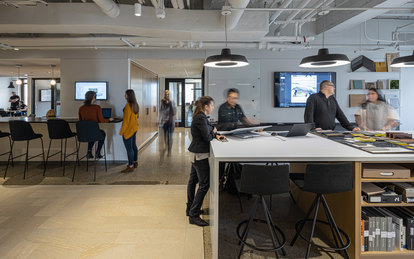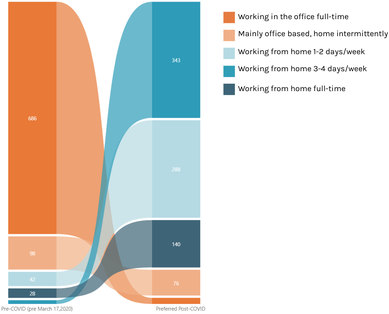The World Has Changed, So Should Our Approach to Work

In an article originally published in Work Design Magazine, Mark Adams & Jenn Lauring share how policies and practices centered on flexibility and empowerment will shape our return to the office and the future of work.
Almost immediately after remote operations were initiated a year ago, SmithGroup’s firm leaders formed a Reintegration Task Force to prepare a comprehensive framework plan for safely returning employees to physical offices at a yet-to-be-determined date. The group, led by SmithGroup’s Workplace Practice Director, Lise Newman, included representatives from Human Resources, IT and teammates from across the company’s varied disciplines and geographic locations. A primary task was to research all facets of operations within SmithGroup’s physical offices.
Equally important, leaders wanted to understand what support employees needed to remain successful while working from home. A comprehensive firmwide survey, which received an impressive 92% response rate within 36 hours, revealed that large segments of staff were struggling to contend with issues related to widespread closure of schools, day care centers and public transit. Health, wellbeing, increased stress, concerns of isolation and a desire for more face-to-face interaction and collaboration were also issues which challenged employees.
In May of 2020, to help employees navigate these challenges, SmithGroup’s leadership team rolled out an innovative workplace policy dubbed “non-judgmental flexibility.” Non-judgmental flexibility provided SmithGroup employees the latitude to temporarily adopt flexible or non-traditional schedules—such as half days, split days, weekends, night shifts—to accommodate and balance rapidly changing work/life responsibilities brought on by the pandemic without fear of backlash, stigmatization, or repercussions in the workplace. The policy was extremely well-received by staff and reported by many to have an immediate and positive impact on productivity, personal health and wellbeing.
While it is not yet known to what degree the policy will remain in place once the pandemic subsides, we do know that flexibility and holistic workplace design centered on promoting health and wellbeing will play large roles in recruiting, retaining and operating businesses of all types in the future.
Returning to the Office: Where to Begin
As society prepares to enter this new era of work, companies must assess a range of space- and policy-related adjustments and determine what changes will or will not align with their firm’s unique mission, vision, brand, culture and values.
SmithGroup’s Workplace strategists, design experts and Reintegration Task Force collaborated to develop a comprehensive framework plan that can aide organizations looking for a Holistic Approach for Returning to the Office. Centered around the employee experience, this framework and step-by-step process allows companies to reimagine their workplaces in a holistic way while ensuring employee safety and wellbeing remain a top priority.
Shifting Paradigms & Impact on Real Estate
Certainly, there is much to consider within this new world of work. For many organizations – including SmithGroup – understanding how physical offices and post-pandemic space needs fit into the picture are becoming mounting priorities. Remote work has ignited an honest and in-depth exploration into the role of physical office spaces, the level of flexibility that employees expect from their employers, and what companies are willing to embrace moving forward. And this is just the beginning of a widespread paradigm shift in work styles and modalities across industries, including architecture and design.
SmithGroup is trying to discern how this new era of work will impact performance, profitability, operations, real estate and future space requirements for its enterprise as well as clients’.
While a large portion of businesses would love to take a “wait and see” approach, lease terminations and the inefficiencies of underutilized real estate are forcing the issue for some, including two of SmithGroup’s 14 domestic offices.
SmithGroup – Boston Office
With its lease coming to an end in the middle of 2021, leadership within SmithGroup’s Boston office did not have the luxury of standing by. Prior to the pandemic, the plan was to find a new space equivalent in size to the existing 15,600 sf office, with the majority of employees retaining assigned workstations. However, leadership could not ignore how effective teams had been while working remotely and could not overlook staff’s expressed desires to retain some level of flexibility post-pandemic.
Supporting these observations, a staff survey revealed that 89% of employees were satisfied working remotely but missed the social interaction and collaboration afforded by the office. Also notable pre-pandemic, over 70% of staff reported one-way commute times lasting 40 minutes or longer. Staff shared that going back to 80+ minutes of commute time per day, five days a week was not ideal. One employee explained it simply,
I hope to find a balance between the challenges of my commute and the benefits of being in the office to be able to see, communicate and collaborate with team members and other employees.
Guided by survey results and the staff’s desire to continue to work remotely to some degree, leadership pivoted and leased a smaller floorplate in Boston’s Seaport District. The new office will focus on a range of social, interactive and collaborative activities that employees missed, balanced by areas for quiet and focused work—giving staff flexibility and choice to select the right setting for each task.
SmithGroup – Phoenix Office
Without a full renovation in nearly 20 years, SmithGroup’s Phoenix office was overdue for a transformation to improve the employee experience and better facilitate workflow and processes. Similar to feedback shared by staff in Boston, Phoenix employees reported that they were satisfied with remote work overall but were struggling to cultivate relationships with colleagues, engage in meaningful collaborative activities, and found it challenging to connect with office managers and leaders. Unlike Boston, commute time was less of a constraint (less than 30% of staff reported one-way commute times longer than 40 minutes), but the benefit of “no commute” was still the highest ranked reason people enjoyed working from home. When asked “What has increased productivity working from home and what would you incorporate into the new office?” the number one answer was “focused work with fewer distractions.” In addition to the need for quiet zones for focused work, employee workshops revealed a desire for more natural daylight, increased amenity spaces and various types of collaboration spaces.
The pandemic reinforced programmatic and design considerations and moved the flexibility needle further. SmithGroup’s new office will transition Phoenix from 100% assigned seating to 90% unassigned seating. To promote team-based collaboration and facilitate seamless flow of activities, teams will be able to reserve select areas throughout the office for extended periods of time. This new level of agility and flexibility will further support our goals of greater collaboration and breaking down studio silos that have existed since the inception of the space.
SmithGroup – Overall
While the Boston and Phoenix offices move ahead with their plans, SmithGroup’s Leadership Council is using this time to assess who we are as an organization and how we work. A firmwide survey was deployed that addressed inclusion, engagement and the employee experience asking staff to reflect on their time before COVID-19 and how it compares with their experience working remotely. Staff was asked to imagine a future when the pandemic is behind us and consider the workstyle that would best suit their personal needs and how that may impact the overall culture of the firm.
The results were impactful and eye-opening. The ribbon diagram below highlights the major shift in how/where staff worked prior to COVID and how/where they want to work moving forward. The biggest change comes from the working in the office full-time profile -- 77% of staff respondents worked that way prior to COVID-19, but only 2% want to work that way moving forward. The second largest shift was in the working from home 3-4 days a week consistently profile, only 1% of staff respondents worked that way prior to COVID-19, and 38% want to work that way moving forward.
There is still much to unpack regarding how “temporary” workstyles, methodologies, policies and technologies put in place to navigate COVID-19 could evolve into more permanent solutions. Like many organizations, SmithGroup continues to discern how major shifts in employee desires will impact business operations, real estate strategies and future office design. Continued research and partnership with clients across markets will help fuel further exploration of these topics related to long-term implications of COVID-19—particularly regarding built environments and the people they serve.

